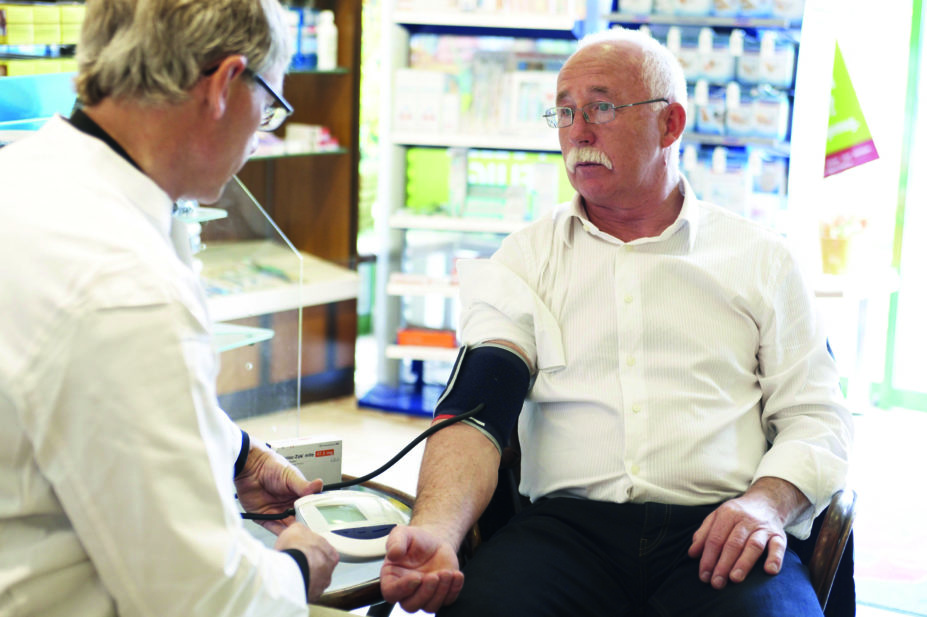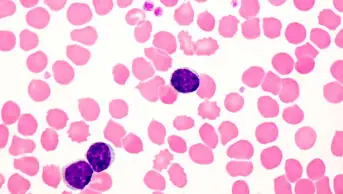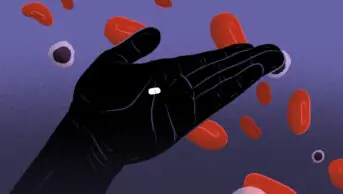
mauritius images GmbH / Alamy Stock Photo
The growing burden of cancer in the community
With 356,860 new cases of cancer recorded in the UK in 2014 and with 11,236 UK pharmacy contracts in place in 2012, around 32 newly diagnosed cancer patients will visit a community pharmacy each year[1] ,[2] . Cancer is the biggest healthcare worry for more than half of the population (54%), and the number of people affected by cancer is set to double to 4 million in 2030[3] . Around 26% of people in Britain say they want to understand more about their friends’ and family members’ illness, and that they want better information on the symptoms to look out for[4] .
Cancer learning ‘hub’
Pharmacists are playing an increasingly important role in supporting patients with cancer, working within multidisciplinary teams and improving outcomes. However, in a rapidly evolving field with numbers of new cancer medicines is increasing and the potential for adverse effects, it is now more important than ever for pharmacists to have a solid understanding of the principles of cancer biology, its diagnosis and approaches to treatment and prevention. This new collection of cancer content, brought to you in partnership with BeOne Medicines, provides access to educational resources that support professional development for improved patientPrevention, pre-diagnosis, screening and signposting
Pharmacists have proven they can have a role in the direct referral of patients with suspected cancer[7] . The NHS community pharmacy contract in England defines promotion of healthy lifestyles (public health) as an essential pharmacy service. There are now several opportunities during routine consultations to explore lifestyle and offer advice on weight management, smoking cessation, alcohol intake, diet and exercise. The NHS has included this in the service’s six annual local campaigns. For example, the national ‘Be Clear on Cancer’ campaigns have included ovarian, breast, skin and lung cancers. Pharmacists and healthcare professionals should encourage patients with cancer to attend their routine screening appointments in order to prevent avoidable cancer-related harm. CRUK’s ‘Talking About Cancer’ should help to remove barriers, such as coping with ‘false alarms’ from screening or the fear of ‘time wasting’[13] . The role of community pharmacy could also extend to referring patients with suspected cancer. Box 1 lists symptoms that should alert the pharmacy team to the need for referral. A 12-week pilot project carried out in south west London in 2011–2012 found that 55 out of 60 direct referrals to secondary care for suspected lung cancer by community pharmacists were appropriate; while no lung cancer was diagnosed, 14 cases of undiagnosed chronic obstructive pulmonary disease were identified[7] .Box 1: Symptoms of cancer that highlight the need for patient referral
- A persistent cough lasting longer than 3 weeks;
- Unexplained dyspepsia lasting longer than 3 weeks;
- Haematuria;
- Persistent diarrhoea or melaena (passage of black, tarry stools);
- Persistent vomiting or vomiting blood;
- Rectal bleeding;
- Dysphagia;
- Unexplained weight loss;
- Lump or mass in the breast.
Identifying patients with cancer
A MCA will often be the first person to speak to patients and customers in a community pharmacy and needs to assimilate the information provided by the patient, family member or carer and decide who in the team is best placed to help. The opportunity to help patients will present in several ways and may incude a request for advice or an over-the-counter (OTC) product or, during treatment, requests for advice on topics, such as nutrition, skin, oral care, general health and immunity. An acute prescription might be another time to start a conversation; or when you are providing enhanced and advanced services (e.g. medicines use review [MUR] or new medicine service process); or during NHS promotional campaigns. One way a patient may be identified is through a change in frequency of prescriptions and status to medical exemption, which is granted for five years across the UK after diagnosis of cancer. Unfortunately, there is currently no official route for a community pharmacist to be informed of a patient’s diagnosis or any treatment given through secondary care unless he or she asks the patient directly or the patient volunteers the information. It is hoped that summary care records will help this situation in the long term. However, in the meantime, it is good practice for patients on chemotherapy to be given a hand-held record, and pharmacists and healthcare professionals should request that patients bring this to consultations to reinforce the information already given and to inform suggestions about who to signpost them to.Supporting cancer patients on their journey
According to CRUK in 2010–2011, 50% of cancer patients in England and Wales survived for 10 or more years[2] . Consequently, survivorship is a growing area of interest for care[14] . It is important to understand that a patient’s journey is an individual one and that no two treatment pathways are the same; they depend on variables such as tumour type and sensitivities discovered during biopsy, tumour spread, patient age and co-morbidities. For example, in breast cancer, tumours can be hormone (oestrogen or progesterone) sensitive and/or HER2-receptor positive or negative. Care can take a supportive role during treatment, however, the focus will turn towards palliative care for patients nearing the end of life. It is important to signpost patients to local charities according to their needs because some charities will provide services to help the patient during treatment (e.g. counselling, complementary therapy, the ‘Look Good Feel Better’ programme), while others will provide end-of-life care. Pharmacists and healthcare professionals should also be aware that patients will have access to all information from their specialist centre, therefore, messaging is often a reinforcement of what patients will have been told already. From work in Lewis Pharmacy (see Box 2) patients asked questions that would be expected to be discussed in secondary care[12] . Reasons for this may include that the patient needs the information repeated because they don’t always remember information given to them in the consultation. Patients may experience worry or frustration with timescales (e.g. biopsy time), or perhaps do not understand the treatment pathway, particularly during the diagnosis period. Alternatively, patients may just want someone to talk to as they come to terms with their diagnosis and treatment. It is the job of all healthcare professionals to calm their frustration, reinforce advice given already and signpost them to further support.Box 2: How community pharmacists already intervene to help cancer patients[10] ,[11] ,[12]
Case study on Lewis Pharmacy, Exmouth During medicines use reviews (MUR) and other consultations conducted at Lewis Pharmacy, it became apparent that several patients were undergoing various treatments for cancer, in some cases over a long period of time, which the patients assumed the pharmacy would be aware of. There is currently no system in place for a community pharmacy to know what treatments patients are taking outside of the medication that the particular pharmacy supplies. This lack of knowledge about ‘other’ medication means that the community pharmacist has to advise on medication dispensed and give over-the-counter (OTC) advice in isolation. Lewis Pharmacy looked to explore what help was available to community pharmacists and to collect data showing what interventions were required by patients diagnosed with cancer. Method: Suitable patients were identified and recruited and support was offered to them. A MUR was carried out by appointment with a focus on compliance and potential side effects and interaction between chemotherapeutic agents and existing medication. A review of their hand-held record from the specialist centre was also carried out when accessible and signposting details were reiterated. Links with local relevant charities were established, where appropriate, and patients were then offered the support of the community pharmacy team where necessary. Results: Five patients were recruited, all were seen and reviewed initially and then four were seen regularly. One patient had a hand-held record, which meant that dose and signposting instructions could be reiterated. Four patients experienced side effects of chemotherapy and radiotherapy (fatigue, skin issues, joint pain) and referral or OTC advice was given. Advice on nutrition and hair regrowth was requested. One potential interaction between dacarbazine, lansoprazole and newly restarted fluoxetine was flagged. One patient presented for OTC advice on a severe three-day long gastric upset requiring urgent referral, and recurrence was subsequently diagnosed. Finally and, most surprising of all, was that on several occasions the opinion of the pharmacist was sought to answer questions about their disease and prognosis. Conclusions: This study provided some real examples of useful help and care being provided to patients. It would seem that patients are well informed by their specialist centre and the community pharmacist is well placed to reinforce information (e.g. dose regimen, side effect information, OTC advice of minor issues, such as nutrition, hair regrowth, skin and oral care). Recuitment was difficult and requires more thought – patients compartmentalise their cancer treatment away from their regular medication and yet incorrectly assume that a community pharmacist will be aware of all their treatments. Ultimately, a relaxed environment in the pharmacy and a relationship of trust provided a different environment for patients to ask questions.Clinical aspects of care
Patients should be encouraged to give details of their chemotherapy and pharmacists and healthcare professionals should be aware of the potential interactions and side effects. One way this conversation can be initiated is by offering patients a MUR and asking to see their patient-held chemotherapy information/record. During a MUR, pharmacists should consider the following: compliance of all medication, including any oral anticancer medicines because these are given as pulsed treatments with short courses or continuously and may form part of complex regimens[5] . Success of adjuvant therapies (e.g. tamoxifen) depends on compliance, and compliance is related to the severity of side effects[15] . Furthermore, patients can be brand sensitive, so it is important to be sympathetic to this.Interactions
Martindale provides an overview of chemotherapeutic side effects and potential interactions and describes each therapeutic agent[16] , while Stockley’s provides information on specific interactions[17] . Do not assume during MURs that interactions have been accounted for in the specialist centres, because GPs retain control of prescribing their usual medicines and patients who attend as outpatients may not have had a complete medication history taken. Interactions were less common with traditional cytotoxic chemotherapy, but the increased use of targeted agents has seen an increase in the number of potential interactions with chemotherapy[18] . For example, many products can interact with drugs that are metabolised by CYP3A4 (e.g. macrolides, grapefruit, fluoxetine, diltiazem with tyrosine kinase inhibitors [TKI])[18] . Some common interactions could be easily missed, (e.g. proton pump inhibitors and ranitidine decrease efficacy of targeted therapies used in lung cancer [e.g. erlotinib (Tarceva; Genentech)])[18] ,[19] .Side effects
Systemic anticancer therapy (SACT) includes cytotoxic chemotherapy, monoclonal antibodies (MABS; e.g. trastuzumab) and TKIs (e.g. erlotinib and other novel therapies). Long-term (five- or ten-year) cytostatic (rather than cytotoxic) adjuvant anti-hormonal therapies are given for certain cancers (e.g. anti-oestrogenic ovarian function suppression plus an aromatase inhibitor or tamoxifen therapy for breast cancer and anti-androgenic therapy for prostate cancer). In order to gain maximum benefit from treatment, there is a fine line between therapeutic and toxic doses, particularly with cytotoxic chemotherapy, and these medications potentially have many side effects. Common, non-drug specific side effects include: sickness; diarrhoea; hair loss; mouth problems (e.g. ulceration, thrush, taste disturbances); bone marrow suppression that may lead to inability to fight infection and neutropenic sepsis; tiredness and fatigue; and muscle pains. Some drug-specific side effects include: skin-redness; dryness and blistering (including palmar-plantar syndrome) with capecitabine; rash; photosensitivity; cardiovascular toxicity (associated with anthracyclines); and hormonal reactions (e.g. hot flushes) when menopause is induced[20] ,[21] ,[22] . Therefore, pharmacists and healthcare professionals should help patients understand the importance of self care to minimise side effects and should know how to self refer if side effects do occur. Some preventative advice can be reinforced in the community, for example, oral hygiene, skin care, management of fatigue and loss/regrowth of hair. The use of traffic-light-symptom reporting tools is encouraged because these provide recommended actions to patients when they are experiencing side effects[20] .What to do when patients report side effects
Pharmacists and healthcare professionals should contact or refer patients to a specialist centre, especially if there is any doubt. Patients may delay reporting side effects to clinicians, including those that are life-threatening[20] . In general, any reported side effects, particularly signs of infection, mucositis and severe skin reactions, must be referred back to the specialist centre. It is vital that signs of infection (e.g. sore throat, raised temperature, pain passing urine, cough or breathlessness) are referred immediately, because they could be indicative of neutropenic sepsis and require urgent antibiotics[21] . Box 3 outlines where community pharmacists can help, while Box 4 provides lifestyle advice that can be reinforced for patients on chemotherapy.- Patients are at risk from bone marrow suppression and life-threatening neutropenic sepsis from cytotoxic medicines – urgent referral is required;
- Newer targeted therapies are also associated with serious side effects, such as severe uncontrolled diarrhoea, hypertensive episodes and extreme skin toxicities;
- Urgent referral required for neutropenic sepsis – fever, may be due to low white cells;
- Some agents are dose limited by heart failure[12],[22] – look for signs;
- Some agents cause hypertension or ventricular tachycardia – refer.
- Use chlorhexidine to limit potential oral problems (Nystatin may be required);
- Use Doublebase to moisturise skin during chemotherapy and radiotherapy;
- Hand-foot syndrome (redness, swelling, pain) – Doublebase cream, refer if severe;
- Limit the use of vitamin, probiotic and herbal supplements unless proven to be safe[11] ;
- Reinforce lifestyle advice given in the hand-held record;
- Be aware of side effects and brand switching of adjuvant hormonal therapies, such as tamoxifen and aromatase inhibitors.
- Tell doctor immediately if they get a fever (temperature over 38°C) or notice any bleeding or bruising;
- Keep as clean as possible, washing hands before preparing food, for instance;
- Try to eat a healthy diet – lots of fresh fruit and salads;
- Make sure any cooked food is properly heated through to kill off bacteria;
- Avoid injury (e.g. wear thick gardening gloves);
- Keep away from animals to avoid infection, especially cat litter trays and bird cages;
- Put pressure on cuts for longer than usual to stop bleeding;
- Rest when feeling tired;
- Avoid doing too much in the middle of each course of chemotherapy, as this is when blood counts will be lowest;
- Avoid any contact with people who have, or may have been in contact with, chicken pox.
Consider patients holistically and compile a portfolio of local help for signposting
The process of having cancer and being treated is wearisome. Initially there is the shock of diagnosis, followed by suspension of ‘normal’ life (e.g. work, exercise, holidays, doing activities with partner and/or children), while undergoing treatment that can leave the patient and their family emotionally drained. Counselling, lifestyle advice with regard to diet and physical activity[23] , and complementary therapies (e.g. reflexology or massage) have a place during treatment as there is evidence to show the beneficial effects of massage during cancer treatments[24] and post-treatment for rehabilitation[25] . Acupuncture is used routinely at Exeter’s local charity centre, FORCE, to reduce hot flushes and anxiety. Patients may also want to consider yoga, pilates, personal trainers or local gyms to strengthen the core and help return to fitness, so pharmacists and healthcare professionals should be aware of local providers and activities in order to signpost to patients, their families and carers.Collaboration
A University College London School of Pharmacy report, ‘Overcoming cancer in the 21st century’, explored how community and hospital pharmacists can contribute to cutting the incidence of cancer and improving cure rates through optimising medicines use, lifestyle management programmes and providing better services for people living with cancer and the unwanted effects of current treatments[26] . The report says that collaboration is key to success and examples exist where a charity, in association with a large multiple, has run training schemes with their staff[27] . The ACE report[7] outlines training in detail for the whole community pharmacy team in relation to cancer. However, communication between primary and secondary care must be improved. The future of cancer management will involve better tailoring of treatment to the tumour and better understanding of how individuals metabolise medication and how this affects dose. In the future, community pharmacy will likely provide increased support to cancer patients and become increasingly involved in their care. MURs will help identify patients and support their medicine-related issues, while encouraging two-way communication with the specialist centres and their oncology pharmacists to best manage the pharmaceutical care of these patients. This sharing of information and knowledge will likely support an improvement in patient care.Useful resources
Charities- Cancer Research UK (CRUK) website provides scientific information and statistics, training materials and patient resources (including leaflets and posters).
- Macmillan website provides comprehensive information on all tumour types, treatments and individual chemotherapy drugs. They have a nurse-led support line and also employ GPs and pharmacists who work locally on a range of projects.
- The British Oncology Pharmacy Association (BOPA) is a charity and their website has a list of additional resources and an active forum.
References
[1] Chapman C. Are there too many community pharmacies? Pharm Mag 1st April 2014. Available at: http://www.pharmacymagazine.co.uk/are-there-too-many-pharmacies (accessed March 2017)
[2] Cancer Research UK. Health professional - Cancer statistics. Available at: http://www.cancerresearchuk.org/health-professional/cancer-statistics (accessed March 2017)
[3] Maddams J, Utley M & Møller H. Projections of cancer prevalence in the United Kingdom, 2010-2040. Br J Cancer 2012;107:1195–1202. doi: 10.1038/bjc.2012.366
[4] Colquhoun A. Is there a place for cancer therapy provided from community pharmacy? Pharm J 2011;286:144. Available at: http://www.pharmaceutical-journal.com/opinion/comment/is-there-a-place-for-cancer-therapy-provided-from-community-pharmacy/11067691.article (accessed March 2017)
[5] Williamson S. A Report on the dispensing and supply of oral chemotherapy and systemic anticancer medicines in primary care. January 2011. Available at: http://www.rpharms.com/support-pdfs/providing-oral-chemotherapy-in-the-community-%282%29.pdf (accessed March 2017)
[6] Hardy I, Lewis J & Koundakjian J. Dispensing of oral chemotherapy in the community: a viability assessment in the UK. Eur J Oncol Pharm 2008;2:29–32. Available at: http://www.esop.li/downloads/library/ejop2008_2_full_noads.pdf (accessed March 2017)
[7] ACE Report: pharmacy training for early diagnosis of cancer (NHS, CRUK, Macmillan) October 2015. Available at: http://www.cancerresearchuk.org/sites/default/files/ace_pharmacy_training_report_final.pdf (accessed March 2017)
[8] Todd A, Copeland A, Husband A et al. The positive pharmacy care law: an area-level analysis of the relationship between community pharmacy distribution, urbanity and social deprivation in England. BMJ Open 2014;4:e005674. doi: 10.1136/bmjopen-2014-005764
[9] Badenhorst J, Todd A, Lindsey L et al. Widening the scope for early cancer detection: identification of alarm symptoms by community pharmacies. Int J Clin Pharm 2015;37(3):465–470. doi: 10.1007/s11096-015-0078-3
[10] Lewis J. Caring for cancer patients in the community pharmacy – initial findings. (Presentation), Royal Pharmaceutical Society Conference 2014
[11] Hall R, Jenks P & Lewis J. Caring for cancer patients in the community pharmacy. (Presentation), British Oncology Pharmacist Association (BOPA) Symposium 2015
[12] Lewis J. Caring for cancer patients in the community pharmacy. (Presentation), The Pharmacy Show 2016.
[13] Cancer Research UK. Future Learn – Talking about cancer. Available at: https://www.futurelearn.com/courses/talking-about-cancer (accessed March 2017)
[14] Macmillan. The Macmillan living with and beyond cancer programme. Available at: http://www.macmillan.org.uk/about-us/health-professionals/programmes-and-services/living-with-beyond-cancer-programme.html (accessed March 2017)
[15] Abderrahman B & Craig Jordan V. Improving long-term adjuvant anti-oestrogenic therapy for breast cancer. Clin Pharm 2016:8(6)180–190. doi: 10.1211/CP.2016.20201203
[16] Martindale: the complete drug reference. Pharmaceutical Press. Available at: https://www.medicinescomplete.com/mc/martindale/2009/ (accessed March 2017)
[17] Stockleys Interactions Checker. Pharmaceutical Press. Available at: https://www.medicinescomplete.com/mc/alerts/current/drug-interactions.htm (accessed March 2017)
[18] Conde-Estévez D. Targeted cancer therapy: interactions with other medicines. Clin Transl Oncol 2017;19(1):21–30. doi: 10.1007/s12094-016-1509-x
[19] Lee R & Sawyer J. Interactions with Erlotinib and Gefitinib. Pharm J 2011;286:134. Available at: http://www.pharmaceutical-journal.com/learning/learning-article/interactions-with-erlotinib-and-gefitinib/11067716.article (accessed March 2017)
[20] Oakley C, Chambers P, Board R et al.; National Chemotherapy Board, good practice guideline. Promoting early identification of systemic anti-cancer therapies side effects: two approaches. 1 September 2016. Available at: https://www.rcplondon.ac.uk/education-practice/advice/specialty-spotlight-medical-oncology (accessed March 2017)
[21] Williamson S. Managing cancer patients in community pharmacy. The Pharmacist 2009. Available at: http://www.thepharmacist.co.uk/c47-services/managing-cancer-patients-in-community-pharmacy/ (accessed March 2017)
[22] Kenigsberg B, Campia U & Barac A. Cardiovascular side effects of cancer treatments. Clin Pharm 2016:8(9):279–288. doi: 10.1211/CP.2016.20201651
[23] Spark L, Reeves M, Fjeldsoe B & Eakin E. Physical activity and/or dietary interventions in breast cancer survivors: a systematic review of the maintenance of outcomes. J Cancer Surviv 2013;7(1):74–82. doi: 10.1007/s11764-012-0246-6
[24] Sturgeon M, Wetta-Hall R, Hart T et al. Effects of therapeutic massage on the quality of life among patients with breast cancer during treatment. J Altern Complementary Med 2009;15(4):373–380. doi: 10.1089/acm.2008.0399
[25] Cheville A & Tchou J. Barriers to rehabilitation following surgery for primary breast cancer. J Surg Oncol 2007;95:409–418. doi: 10.1002/jso.20782
[26] Gill J, Sullivan R & Taylor D. Overcoming cancer in the 21st century [Lecture/Presentation]. UCL School of Pharmacy January 2015.
[27] Fowells A. Extraordinary services – caring for cancer patients. Chem Drug 2015:20–22


